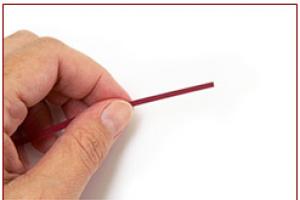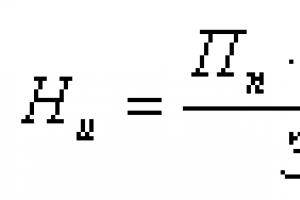Devices such as homemade feed cutters and feed choppers will help feed livestock much faster and more conveniently required quantity food. The presence of such tools is especially important if there are a lot of animals, and their food should be of different quality and degree of grinding.
You can make a feed cutter and other tools with your own hands from scrap items or unnecessary details household appliances.
- 1. The first one includes a propeller with slightly concave blades. It should be installed closer to the bottom of the drum. Its tasks are to throw the feed up and push out the crushed particles from the feed cutter.
- 2. The second knife is the main cutting element, it can be made from a blade old saw. The following picture shows what the blades look like.
- bucket;
- chopper;
- bunker;
- Bulgarian;
- lid;
- cutting element;
- stand;
- outlet for releasing food.
Show all
Creating an electric feed cutter from a washing machine
In order to make this unit, you need to use some materials that can be extracted from old household appliances. Before you begin work on creating an electric feed cutter, you will need a washing machine, from which you will need to remove the motor and drum.
Hole
Specifications such as the width, height and length of the slot should be the same as the motor shaft. After the measurement has been taken, you need to start drilling the outer sides of the drum. Here you need to create three slots for the bolts - 2 identical and 1 smaller, as in the figure above.
One of the walls must have an outlet (for discharging feed) in the form of an additional iron part, which is separately attached to the drum. The finished product will come out of it. In the following figure you can see this design.

Fragment for ejecting feed from the drum
This completes the main stage. Now you need to start working with the cutting part of the device.

Blade of the device
The cutting part must be secured to the motor shaft using bolts. For this design you need to use 2 knives:

The knives are slightly curved in shape. This increases the productivity of the electric feed cutter. After completing the creation of the device blade, you need to start making the support.

Electric feed cutter stand
The support in this device is a metal structure that resembles a stool. Attach to it assembled structure using bolts.

Stand
In the picture above you can see the stand in more detail. It does not need to be additionally covered with sheets of iron.
This is the job of creating an electric feed cutter from washing machine completed. The result is an effective feed cutter from a washing machine. This device is capable of processing much more feed than conventional manual grass cutters.

Feed cutter - schematic representation of the final result

Making a shredder from a cylinder or durable bucket
When working on creating a device, you first need to evenly separate one part of the gas vessel from the other, using a grinder, so that you get two almost identical cylinders. Next you should take one half and prepare iron form for the blades, as shown in the following image.

Bottom of the cylinder
Having completed these manipulations, you can proceed to working with the blades. To do this you will need to bend them slightly. Then attach the knives with screws to the prepared iron disk, which should have pre-made slots.
The figure below shows in finished form what this fragment should look like.

Cutting elements
After creating the cutting elements for the feed cutter, an opening should be cut out of the cylinder using a grinder. This should be done on the side of the gas vessel.
Under the disk with the blades shown in the image above, you need to install an iron stand with a cut-out opening, which should look like a stool in appearance, to connect the disk and cutting elements to the engine.

A cylinder with a disk attached to an iron stand and a motor under it
The motor, in turn, is installed under an iron stand. Thus, a device for grinding feed is obtained. You need to attach a bucket to it, where the finished product will be poured - as in the image above.
How to make a feed cutter from an angle grinder?
A disk device can be made at home from a corner grinding machine. There are different drawings for this, but the most popular is the diagram of a feed cutter made from an angle grinder.

Feed cutter diagram
You can see everything in the diagram on the left necessary elements designs:
The electric feed cutter includes a bucket made of high-quality steel. In the image it is schematically represented by the number 2. At the bottom of this object, you should drill a hole in the center with a diameter of 1 cm - in the diagram this part is marked with the number 3. In the bottom of the bucket you also need to make holes along the edges (two on the right and left), the size of which should be 15 mm.
Next, you should prepare the stand - its parts are marked with numbers 4 and 6. Then make holes on its base (number 4 in the diagram) - just like at the bottom of the bucket on the outer sides. After this, fasten these two items with bolts. Next, you need to connect the motor from the grinder (number 7) to the disk (number 5). On this main stage work completed. You can begin to create the feed exit opening.
It is necessary to cut a hole at the bottom of the bucket and insert a part that will be designed to release food for animals (it can be seen in the diagram under number 2, near the base under number 4 at the cut site). The chopper must contain a lid with an additional hole in the center (number 1). Feed is placed in it for subsequent processing. If necessary, the central part is additionally covered with a smaller lid so that the raw materials do not fly out during processing. This completes the creation of the feed cutter.

In this article we will present to your attention an idea for self-production spiral grater. The manufacturing process is extremely simple, but the result will definitely surprise not only you, but also your family and friends.
What we need:
- hacksaw for metal;
- PVC pipe;
- blade from a stationery knife;
- glue gun.

First of all, stepping back from the edge of the pipe by approximately 10-20 mm, we make an incision using a hacksaw to the middle. According to the author, the angle of the cut should be chosen individually, since the thickness of the cut carrots or cucumbers depends on this angle.


After making the cut, take a utility knife and cut out all the burrs.

We measure 20-25 mm from the cut made in the previous step and cut off the pipe.

We again process the incision site using the same stationery knife.

The blank for the final assembly of the future grater is ready. At this stage, you need to rinse it thoroughly with alcohol and disinfect it. The blade of a stationery knife must be boiled in water for approximately 10-15 minutes, then lubricated vegetable oil so that the blade does not rust in the future.

Now insert the blade into the cut.
We take a marker and mark with lines the places that remain outside the pipe.

Using pliers, carefully break off all excess.

Finally, to prevent the blade from accidentally jumping out of the cut, drop a few drops of hot glue into the cut.
A self-made electric grater allows you to get finely chopped vegetables and fruits.
Although the original goal was to have our own starch, that is, to make it at home. To do this, it was necessary to make a grater equipped with an electric motor and starting equipment.
The hopper and casing can be completely riveted by yourself, but the driving and driven pulleys had to be taken from an old Riga-60 washing machine. The design of an electric grater is very simple; anyone with even a little knowledge of technology can make it.
The operating principle of such an electric grater is as follows.
A grater disk rotates inside the hopper at a speed of 600-700 rpm. Pour washed potatoes in their skins into the hopper. To prevent the tubers from slipping through entirely or in large pieces, limiters are installed on both sides in the center of rotation of the grater disk with a gap between them (the sides) and the grater disk.
We turn on the unit, place the dishes under the grater - and just have time to add the potatoes. The smallest tubers will be used for starch.
Electric grater: 1 - hopper Art. 1 mm; 2 - corner frame 25 x 25 x 2; 3 - electric motor from the washing machine; 4 - grater disc, stainless steel. steel 1.5 mm; 5 - driven pulley from the washing machine; 6 - ball bearing 202 (2 pcs.); 7 - flange; 8 - limiters, steel 2 mm; 9 - housing, bearing with driven shaft.
Manufacturing of hopper and casing
 The dimensions are shown in the figure, all that remains is to add that it is better to make them from thin metal 1 mm thick. This is quite enough. You just need to select the metal so that it does not oxidize.
The dimensions are shown in the figure, all that remains is to add that it is better to make them from thin metal 1 mm thick. This is quite enough. You just need to select the metal so that it does not oxidize.
Making a disc.
On the disk we use a special notch for the grater. For convenience and to obtain torn and sharp edges, we cut one hole after another at the end of the hardwood. First, on a disk with a diameter of 250 mm, you need to mark the holes in a spiral, and then alternately cut one hole on one side, another on the other. And so on until the end throughout the entire disk. The holes should be tetrahedral, with  antennae. Over time, after a long period of operation, they will have to be renewed.
antennae. Over time, after a long period of operation, they will have to be renewed.
The article shows step by step, with photographs, how to sharpen the cutting surface of a grater with an ordinary drill yourself and very simply, and most importantly quickly, if you don’t disassemble it like I did.
Any vegetable grater, when used, loses its cutting properties over time. The sharp edges that turn vegetables into minced meat or delicately cut strips become dull and the torment begins. This is easy to fix, and I'll tell you how below. Almost all graters are made according to the same principle, and these instructions will be applicable to almost any type of grater.
Not very long ago my wife bought a nice little vegetable grater, not very large sizes and, as often happens, she put her purchase in the closet. Everything looks fine.

Then, when she needed to grate vegetables, she took it, tried to use it for its intended purpose and was disappointed with this seemingly high-quality thing. She did not want to perform her functions. I examined it and found that the cutting edges on the grater were completely blunt. It says German quality, but as often happens, it was apparently made by our neighbors from China. Whether you like it or not, you need to sharpen it. But before sharpening, I decided to disassemble it for better sharpening. It is easy to understand and the photographs show how to do it. The main thing is not to rush and do everything carefully, with feeling, sensibly, and in order.


Here comes the hero of the occasion, the drum that doesn’t want to work.



In order to disassemble the drum for sharpening, you need to remove the locking ring from the latches. Be careful not to break them. Carefully pull the drum to the left as shown in the photo.




We measure the diameter of the holes, I got 2.5 mm, take the same drill, preferably a very good and new one. We insert it into a screwdriver, drill, drill, etc. The main thing is that there are as many revolutions as possible and at a large angle, as in the photo, we drill all the holes. The results are very sharp edges. Q.E.D.

If desired, these sharp edges can be made even sharper by using a drill and a diamond bur to go through all the holes, but this is optional. And the very sharp edges can hurt your hands. The method of sharpening with a diamond bur can be used constantly, if you do not allow the cutting edges of the vegetable cutter to become too dull.
Most vegetable graters can be sharpened using this method. You just need to select drills according to the diameter of the holes, since there are different types of graters.
Tests on vegetables showed that the method works great.
That's all. Ask questions, comment, share on social networks.

IN agriculture Having available tools is very necessary, since the process of raising livestock or poultry takes a lot of time and causes a lot of trouble. Designs such as a feed cutter will make work easier and make it possible to provide all animals with food on the farm. A large number of animals will not be allowed to make food manually, there is simply not enough time for this, various devices will help to cope with the tasks.
Design and technical description
A mechanical product will require a motor in the design. Applicable single phase motor with a prepared bushing, which is made in the form of an adapter. The emphasis of the cutting knife is created by the legs, which are fixed to the plate through an adapter; their purpose is to release the finished product from the container. The blade mount of a DIY feed chopper should be recessed into the design for a more consistent product output.
Making a body with your own hands requires the use of a steel pipe with a diameter of at least 30 cm, with a pre-prepared hole for the feed to exit. The structure is fastened to a support or wooden board, to which metal corners or studs are attached. The feed cutter drum is secured by welding to the corners, just like the engine.
The housing has a front cover through which feed is loaded. Back cover serves as access to the cutting element, has a hole designed for unscrewing the bolt securing the knives. The front cover is complemented by a feed supply structure made of metal plate. The body is secured with metal plates around the perimeter by welding.
Principle of operation
When the electric motor starts, the mass for grinding is fed into the loading hole with your own hands. The knives rotate at low speed, cutting the product into the required pieces, the blades remove the finished mass to the outlet. By adjusting the gap between the cutting edges and the plate, you can achieve cutting quality and process different raw materials. The harvested feed is fed against the location of the stems to increase speed and also to prevent clogging of the structure.
For increased productivity, the knives are installed in a cross-shape. If necessary, an electric motor with a power of 3000 rpm is installed. Drawings of a homemade feed chopper will help you calculate the productivity and degree of cutting of raw materials.
Advantages of do-it-yourself feed choppers
The main advantages of a homemade feed cutter is that it can be adapted to meet the necessary needs. Homemade design can be made from improvised materials available on the farm.
Making the simplest feed cutter involves having a tin bucket made of of stainless steel, more complex designs made from an old washing machine.
Using a grinder or a high-speed drill in feed cutting also provides the possibility of cutting herbal varieties stern. All designs and accessories of a self-made feed cutter are made according to drawings.
Types of Shredders
There are different types of feed for livestock and poultry, succulent types of feed, grains and herbaceous varieties. Each design implies manufacturing for convenient use and the production of a high-quality product.
The variety of designs makes it possible to use the device in various fields. We produce manual feed cutters with a track mechanism, straw cutters, as well as hand mills. Do-it-yourself mechanized feed cutters are, in most cases, equipped with electric motors for maximum productivity in household or industrial settings. There are universal devices capable of grinding different kinds feed by replacing the cutting element.
Juicy feed chopper
Juicy feed is crushed using a grater with large notches. When the process requires mechanization, an electric motor is used, to which a bucket and grater are attached. The feed cutter is manufactured in accordance with a pre-prepared drawing, the bucket is reinforced by welded strips at the edging, with a width of 1 cm. Holes for the buddy are made across the entire area of the bucket in the desired order.
To make the frame, a small table is used, which is installed a few centimeters below the rear part. Filling with food uses a homemade box, which is installed at an angle of up to 40⁰ relative to the main container. At the very bottom there is a collection tray finished products. The low-speed engine drives the chopper, which is located as close to the walls as possible for better grinding.
Cereal grinder
Cereals are processed universal type feed cutter The main difference is the use of a different type of cutting element and engine speed. The presence of a mesh in the design allows you to regulate the degree of grinding of grain crops; the throughput is controlled by opening the door. For a reliable slave, a single-phase two-speed motor with a maximum speed of up to 3000 per minute is used.
The size of the finished raw material can be adjusted with your own hands by installing a sieve various types. Ground grain or other materials may be passed through the machine several times to achieve the desired result.
Grass chopper
The design features do not differ from the above examples, however, special parameters must be observed. The container for the shredder is selected with your own hands depending on the volume of work; the shape must correspond to the cylinder. A rectangular hole is made in the lower part, adapted for the ejection of finished products through a box fastened with rivets.
The power of the feed cutter engine is selected depending on the selected container, the main criterion is the number of revolutions, it should be maintained at 3 thousand/min. The cutting element is made from available stainless steel products.
Feed cutter grater
The most common method of processing raw materials in the household is a feed cutter from a grater. A homemade feed cutter of this kind allows you to produce ready-made feed for a small amount household. Making a structure with your own hands is not difficult; drawings may not be needed at all. Some basic elements for making the case:
- Stainless steel sheet, a 30x50 piece will do.
- Plate connecting elements.
- The lever with which the rotation will occur.
- Table top for mounting.
Making a manual feed cutter with your own hands is quite easy; you need to follow the correct sequence of steps. The lid holes are cut to the required diameter for high-quality cutting. The manufacturing process will not take much time if you have the accompanying materials and tools.
Grinder feed cutter
For increased tool performance, more serious parts are needed. The grinder is suitable as an electric drive for a self-made feed cutter. The container is selected carefully and must be made of thick steel. A stainless steel tin bucket is suitable for the work. Holes of just over a centimeter are made in the walls, and the edges are folded for a cutting effect.
The frame is constructed from metal corners. To connect to the feed cutter body, you need to punch a hole in the bottom of the bucket. The resulting structure will serve as a drum; the collection container is made from a bucket larger diameter, or sheet steel. The grinder is bolted to the inner bucket and rotates it to obtain the finished product.
The vertical arrangement allows the workpieces to be pressed under their own weight during processing. Adjusting the speed of the grinder in the feed cutter with your own hands makes it possible to influence both the quality and the speed of grinding. To preserve the mass of raw materials inside the drum, it is necessary to close the opening for loading feed.
Feed cutter from washing machine
An old washing machine can be used around the house. Pre-prepared drawings will tell you how to make a feed cutter from a washing machine. The main elements are the drum, housing and engine.
A hole with a diameter corresponding to the shaft drive is drilled in the drum body. Mounting bolts are installed in four places to secure the drum. To throw out the food, a hole is cut in the wall. The electric motor is fastened with bolts, which also serve as a connection for knives made by hand. The primary knife is made with a rounded edge to eject feed from the bottom of the drum. The next knife is sharpened from the blade of an unused hacksaw.
Preservation of feed inside the structure is achieved through a lid that is mounted on hinges. At the exit, a self-made container is installed, adapted to collect the finished mass. The productivity of this design can reach up to 100 kilograms per hour; the installation can be used for juicy grinding and herbs.
Making a feed cutting tool with your own hands will not take a lot of effort and money. Ready solutions They are sold in specialized stores, but their prices are high due to the new parts installed. A DIY product can last quite a long time. different needs and farming needs.








